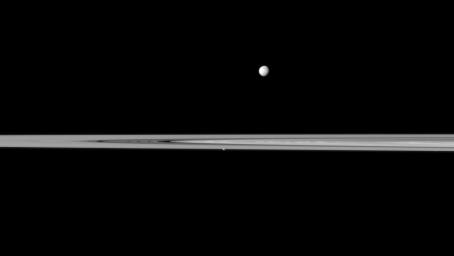Saturn's small, potato-shaped moon Prometheus appears embedded within the planet's rings near the center of this Cassini spacecraft view while the larger moon Mimas orbits beyond the rings.
Mimas (396 kilometers, or 246 miles across) is near the center top of the image and is farthest from Cassini here. Prometheus (86 kilometers, or 53 miles across) looks like a small bump lying in the edge of the rings closest to Cassini in this view. Prometheus actually orbits in the Roche Division between the A ring and thin F ring, and it periodically perturbs the F ring. See PIA08397 to learn more. Atlas, an even smaller moon at 30 kilometers (19 miles) across, also orbits in the Roche Division and can just barely be detected as a bright dot in the rings (at the "bottom" of the rings) on the far right of the image.
This view looks toward the northern, sunlit side of the rings from just above the ringplane.
The image was taken in visible light with the Cassini spacecraft narrow-angle camera on May 16, 2011. The view was acquired at a distance of approximately 2.7 million kilometers (1.7 million miles) from Mimas. The view was acquired at a distance of approximately 2.5 million kilometers (1.6 million miles) from Prometheus and Atlas. Image scale is 16 kilometers (10 miles) on Mimas and 15 kilometers (9 miles) per pixel on Prometheus and Atlas.
The Cassini-Huygens mission is a cooperative project of NASA, the European Space Agency and the Italian Space Agency. The Jet Propulsion Laboratory, a division of the California Institute of Technology in Pasadena, manages the mission for NASA's Science Mission Directorate, Washington, D.C. The Cassini orbiter and its two onboard cameras were designed, developed and assembled at JPL. The imaging operations center is based at the Space Science Institute in Boulder, Colo.
For more information about the Cassini-Huygens mission visit http://saturn.jpl.nasa.gov. The Cassini imaging team homepage is at http://ciclops.org.

 Planetary Data System
Planetary Data System












